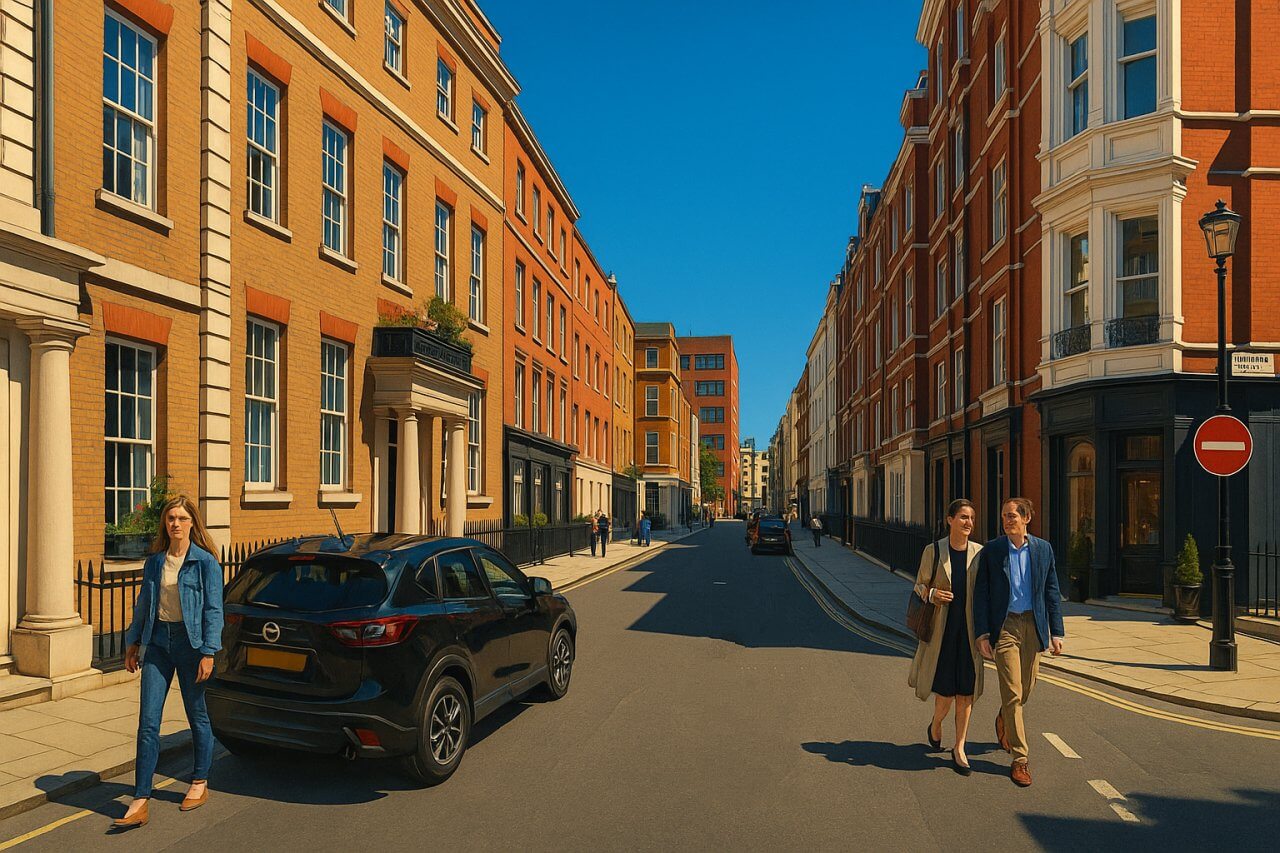
Clifford Street, London
Clifford Street is a short yet elegant road in the heart of Mayfair, situated within the City of Westminster. This historic street runs from New Bond Street in the east to Savile Row in the west, placing it at the centre of one of London’s most prestigious and fashionable districts. It forms a T-junction with Cork Street to the south and is intersected by Old Burlington Street, creating a crossroads that adds to its charm and connectivity.
Layout and Traffic
Clifford Street measures approximately 160 metres (525 feet) in length and is a one-way street running westbound from New Bond Street to Savile Row. Vehicular access is limited, making it relatively quiet compared to the more heavily trafficked Bond Street. The road has wide pavements and is lined with period architecture that reflects Mayfair’s enduring affluence and heritage.
Historical Background
Clifford Street was laid out in the early 18th century during the rapid development of the Burlington Estate. It appeared on maps by the 1720s, forming part of the transformation of Mayfair from fields to fine townhouses and elegant streets for the aristocracy and merchant class.
The street is named after the Clifford family, likely in honour of Thomas Clifford, 1st Baron Clifford of Chudleigh (1630–1673), a prominent political figure during the reign of Charles II. Naming streets after noble families was a common practice in Georgian-era London, particularly on newly developed aristocratic estates.
Pronunciation
Clifford is pronounced CLIF-ərd, with the International Phonetic Alphabet rendering it as /ˈklɪf.əd/. The name is simple and widely recognised in English-speaking contexts.
Character and Atmosphere
Clifford Street offers a blend of restrained Georgian elegance and contemporary Mayfair sophistication. The buildings are typically four to five storeys high, many with original period features and classic brick façades. The street is home to high-end retailers, fine art dealers, and private offices, all of which contribute to the atmosphere of exclusivity.
Unlike the bustling crowds of Oxford Street, Clifford Street exudes a quiet affluence, serving more discerning clientele. It is also a popular location for bespoke tailoring and luxury boutiques, owing to its proximity to Savile Row and Bond Street.
Nearby Sights and Attractions
- Royal Academy of Arts – A major art institution located nearby on Piccadilly.
- Savile Row – The world-famous street for bespoke tailoring, just west of Clifford Street.
- New Bond Street – One of London's premier shopping streets, known for luxury brands and designer stores.
- Burlington Arcade – A historic covered shopping arcade just to the south-east, filled with refined retail options.
Real Estate and Property Values
Properties along Clifford Street are among the most expensive in central London. As of 2025, commercial space in the area can command prices of over £2,500 per sq ft (£26,910 per sq m) for premium units, while upper floors converted into flats or office suites typically fall within £1,800–£2,200 per sq ft (£19,375–£23,680 per sq m)1.
Residential opportunities are limited, with many buildings designated for mixed-use. However, when available, flats in period buildings can fetch upwards of £3 million for two-bedroom apartments around 1,200 sq ft (111.5 sq m). Compared to wider London, these prices reflect Mayfair’s consistent place among the city's most desirable postcodes.
Transport and Accessibility
Nearest Underground Stations
- Green Park – Served by the Jubilee, Piccadilly, and Victoria lines (approximately 6 minutes’ walk).
- Oxford Circus – Served by the Bakerloo, Central, and Victoria lines (about 10 minutes’ walk).
- Bond Street – Served by the Central and Jubilee lines, and the Elizabeth line (roughly 7 minutes’ walk).
Nearby Bus Stops
- New Bond Street / Royal Academy – Served by buses 6, 13, 23, 139, and 453.
- Regent Street / Conduit Street – Served by buses 12, 22, 88, and 159.
Despite being a quiet street, Clifford Street benefits from excellent connectivity due to its central Mayfair location and proximity to major transport nodes.
Fun Fact
Clifford Street is home to a centuries-old private club, the Arts Club, established in 1863 and long associated with creatives, thinkers, and cultural elites. Although the club moved to nearby Dover Street in the 1890s, Clifford Street was its original location. This historic connection adds a touch of intellectual flair to the area’s otherwise commercial identity.
Quick Facts
- Location: Mayfair, City of Westminster, London
- Connects: New Bond Street (east) to Savile Row (west)
- Length: Approximately 160 metres (525 feet)
- Traffic Direction: One-way westbound
- Named After: Thomas Clifford, 1st Baron Clifford of Chudleigh
- Pronunciation: CLIF-ərd /ˈklɪf.əd/
- Character: Georgian architecture, art dealers, private offices
- Nearby Sights: Savile Row, Burlington Arcade, Royal Academy of Arts
- Nearest Tube Stations: Green Park, Bond Street, Oxford Circus
- Bus Routes: 6, 13, 23, 88, 139, 453, 159
- Property Prices (2025): £1,800–£2,500 per sq ft (£19,375–£26,910 per sq m)
- Fun Fact: Original site of the Arts Club (founded 1863)
References
Map of Clifford Street, London

Painting of Clifford Street, London (View image in full size)